No species left behind: Reflections on wildlife conservation for the Nature Conservancy of Canada’s 56th anniversary
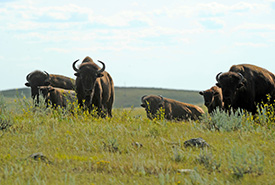
Plains bison (Photo by Mark Taylor)
One hundred and thirty years ago, there was not a single living wild plains bison left in Canada. The planet was a few hundred bulls, cows and calves away from witnessing the extinction of one of North America’s largest living land animals. The great herds that had shaped the ecology and cultures of the Great Plains for millennia had shrunk from over 30 million individuals to a few scattered survivors behind fences in Manitoba, Montana and Texas.
Starting in 1906, Canada then played a key role in preventing the extinction of plains bison. When the U.S. Congress turned down an opportunity to buy a herd that had been assembled by a Montana rancher named Michel Pablo, the Canadian government stepped in and purchased the 695 bison for $170,000. The herd was shipped north to new national parks that had been established to protect and restore declining wildlife species. These actions changed the fate of plain bison forever.
Today, almost all of the plains bison in Canada — from the animals recently introduced to Banff National Park in Alberta, to the Nature Conservancy of Canada’s herd at Old Man on His Back Prairie and Heritage Conservation Area in Saskatchewan — are ancestors of that early conservation save. Although the current population of bison is a tiny fraction of what it once was, this species is no longer likely to become extinct. There are continuing efforts to restore additional wild herds throughout western Canada.
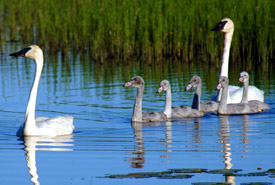
Trumpeter swan family (Photo by Karol Dabbs)
Canada’s brief history is marked by many successful efforts to save wildlife species after they faced extinction. Due to [reasons for extinction], plains bison, pronghorns, grey seals, trumpeter swans and many other wildlife species were once almost gone. However, as a result of the conservation efforts of past generations, these species remain a part of Canada today.
There are many threats to Canada’s wildlife. While some, such as over-hunting and our use of persistent pesticides like DDT, have been greatly reduced, new threats of invasive species and climate change have emerged. One threat has remained, and until we solve it, we are all destined to continue to witness the loss of our Canadian wildlife. That threat is habitat loss.
Habitat loss has been a threat to wildlife since European colonization. The difference today is that we are approaching thresholds that many wildlife populations cannot sustain. Today, there is no more frontier where wildlife lives without our influence. Our human footprint is wide and deep. Wildlife species are being pushed to the edge as we break their habitats into smaller and smaller fragments.
A renewed focus on wildlife
Recently, much of Canada’s conservation focus has been on doing our part to help achieve a global target of protecting 17 per cent of lands and inland waters by 2020. We have made good progress and are on track for success 1. This is a critical milestone for conservation that we should celebrate.
But something is missing. Bird song is dimming in our prairies, butterfly species are disappearing, more plants and animals continue to be added to our list of species at risk of extinction. While we rush to ring the bell when we reach the target of 17 per cent protected areas, the diversity and abundance of many wildlife species have been declining.
How much we protect is important, but the most urgent targets for conservation are the wild spaces and species that we must protect now, while we still can. Large protected areas in Canada’s hinterlands are necessary for our country to reach the 17 per cent target and will help conserve some the last places of global wilderness 2. But protection in these places will not stop the loss of Manitoba’s prairies, the hardwood forests of southern Ontario or coastal Douglas fir ecosystems in BC.
Hand in hand with the global target to increase the amount of protected areas on our planet, there is also a target to stop the extinction of wildlife. For conservation to be effective and lasting, it is the awareness of the urgent needs of our wildlife that should be directing both how much we protect and what we protect.
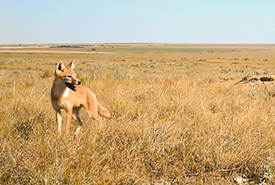
Swift fox in southern Alberta (Photo by NCC)
Canada has a long history of global leadership in species conservation. We are one of the birthplaces of game management and national parks. We are a nation of spectacular, but largely unknown, stories of wildlife recovery that range from peregrine falcons to swift foxes. The recent WWF Living Planet Report shows that the rate of wildlife decline is lower in North America than any other region on the planet 3. But there is more we need to do.
Despite an awareness of species extinctions and a rich history of extraordinary efforts to prevent the loss of species, Canada is continuing to lose both the abundance and richness of wild plants and animals. Our global leadership in wildlife protection seems faded today, as countries like Rwanda and Uganda have been able to increase numbers of mountain gorillas, while the last southern mountain caribou in the Canadian Rockies is inching closer to existing only in memory.
Can Canada lead the world in stopping extinction by committing to zero species loss?
Canada has an unparalleled opportunity to protect wilderness in our North. Future Canadians will be grateful if we do so. Conservation here will help protect species such as woodland caribou, wolverine and olive-sided flycatcher that occur over vast areas of Canada, but that are at risk because they are declining and are facing a growing number of threats.
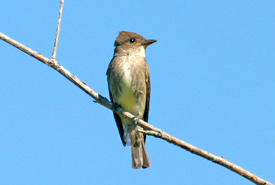
Olive-sided flycatcher (Photo by R. Hocken)
But we also need to urgently protect wildlife in our south — where most Canadians live and where many of our forests, wetlands and grasslands have been lost. The vast majority of Canada’s most critically endangered species occur in our southern geography, where habitat loss has pushed them to a handful of locations. In many cases, such as BC’s Garry oak ecosystems, or the marshlands of the St. Lawrence estuary or Nova’s Scotia’s coastal plains flora, these endangered species live in just a tiny fraction of the Canadian landscape. Greater effort in these “hot spots,” through place-based conservation action and community engagement, is needed to stop species loss in Canada over the next decade.
This month, the Nature Conservancy of Canada will mark 56 years of conservation. In that time we have protected habitats for over 200 different species that are at risk of being lost from our country. In the last decade, these efforts have been accelerated thanks to support from the Government of Canada’s Natural Areas Conservation Program and a growing public concern for the fate of our wildlife. Some of our properties help protect species such as barn swallow and monarch, which are still widespread but showing rapid population declines. Other places harbour some of the last places in Canada for species like western prairie white-fringed orchid, eastern loggerhead shrike and gray fox. Our mission was critical in 1962, and it is critical today.
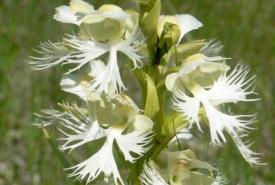
Endangered western prairie white-fringed orchid in the tall grass prairie, MB (Photo by NCC)
We absolutely need to meet our global commitments and protect our share of the planet, but we must bring the diversity of Canada’s wildlife along with us. As the world begins to set the stage for new nature conservation targets, Canada has the opportunity to show leadership with a more ambitious wildlife conservation target for 2030 and beyond. There are stories of wildlife recovery in our Canadian experience that we need to learn, to teach and to replicate. Conservation needs these stories of healing and restoration.
A recent survey by the Canadian Parks and Wilderness Society found that the number one reason why Canadians believe protected areas are important is to conserve wildlife 4. Wildlife puts a face to our parks and protected areas, and can bring hope and imagination to conservation. Targets like 17 per cent protected areas are critical, but for most people it’s just a number. Wildlife inspires.
No species left behind. A commitment to zero extinction that we can start in Canada. It’s a simple promise to future generations. A promise that, if made by each nation, could change the world.
Celebrate our anniversary by helping NCC protect habitat for species at risk across Canada, here.
1. Environment and Climate Change Canada (2018). Canadian Environmental Sustainability Indicators: Canada's conserved areas.
2. J . M Watson, et al., Protect the last of the wild. Nature, 2018. 563: p. 27-30.
3. World Wildlife Fund, Living Planet Report - 2018: Aiming Higher, M.a.A. Grooten, R.E.A.(Eds), Editor. 2018, WWF: Gland, Switzerland.
4. Canadian Parks and Wilderness Society and University of Northern British Columbia, Canadian Space for Nature Survey. 2018.


